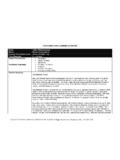Transcription of Apples: A Class Act!
1 There are many apple varieties. The taste of apples dependson many factors latitude, terrain, weather, and the care withwhich they were grown, stored and marketed. About 2,500varieties are grown in the United States. A total of 15 popularvarieties account for about 90 percent of the total appleproduction. Here are the top 10 DELICIOUS The most widely recognized of apple varieties originated in Iowa in the 1870s. Striped to solidred in color, with rich, sweet, mellow taste. Suitable for snacks andsalads, not recommended for pies or cooking. Most widely availableof all varieties, can be purchased DELICIOUSThis old favorite was discovered in West Virginia in 1890.
2 Yellow color, rich, tangy, sweet,juicy flavor. Texture and shape are similar to Red Delicious. Resistsbrowning when sliced. All-purpose apple . Desirable forsalads, snacks, fresh desserts and baking. Available nationwideall red and yellow, this New Zealand native wasbrought to the United States in the early 1970s. Crisp, juicy andvery sweet, Gala is excellent for snacks or salads, and is also goodfor pies, sauce and baking. Galas are available SMITH Green coloring, moderately tartand very firm, this popular variety was discovered by Granny Anne Smith in Australia in 1868. All-purpose apple ,especially good for eating out of hand or baking.
3 Availablenationwide year-round. FUJI Named after the famous Japanese Mt. Fuji, began appearing in markets in the 1980s. This striped yellowand red apple is sweet and firm. Excellent for snacking and salads,Fuji is also a good for pies, baking and sauce making. Fujis areavailable nationwide This popular old variety was discovered byJohn McIntosh in 1811. Mixed green and red coloring. Tart, tenderand juicy flavor. Excellent for eating fresh, not recommended forbaking. Available mainly in the East and Midwest, from Septemberuntil late BEAUTYD iscovered near Rome Township, and red-striped skin. Firm with medium-tart to sweet for baking and cooking.
4 Available nationwide from Octoberuntil Idaho native typically has a large shape, withbright red skin. Firm and tangy, this apple is good for snackingand holds it shape ideally for baking. Available from Septemberthrough Discovered in Woodstock, , in the red stripes over yellow or deep red, darkening to purple inareas. Rich semi-tart flavor. All-purpose apple . Available Septemberuntil spring, mainly in the IMPERIAL Discovered in the early 1800s nearYork, Pa. Slightly tart, firm apple with lopsided shape. Deep red skinwith green stripes. All-purpose apple , best for cooking andbaking. Available mainly in mid-Atlantic region from October untillate by The apple AssociationGrades: 4 6 Apples: A Class Act!
5 Apples are not only one of America s favorite healthysnacks, they are a favorite topic of students of all broad, cross-curricular study of apples provides stu-dents with diverse learning experiences involving nutrition,poetry, the life cycle of fruit trees, scientific investigations andopportunities for library research. This teacher s guide offerssuggestions for accessible and stimulating activities for a seriesof lessons about apples. The unit encompasses many areas ofthe curriculum: math, science, writing, health and nutrition,literature and social of the activities lend themselves naturally to coop-erative learning. Small group or partner work is recommend-ed throughout the unit.
6 Students who talk with each otherreach a richer level of knowledge and understanding than stu-dents who are asked only to perform pencil and paper , Nutritious and Tasty210 Core Facts About ApplesApples are a very good fruit for building healthy bodies. Amedium-sized apple (154 ounces, about the sizeof a tennis ball) fat-free helps maintain a healthy weight, and reduces the risk of some types of saturated-fat sodium-free may help reduce the risk of high natural sugarscalled only 80 cholesterol-free may helpprotect against cardiovascular no artificial colorsor an excellent source of fiber helps reduce blood cholesterol, and aids a convenient, satisfying snack You can take one with you an easy way to get your recommended fiveservings of fruits and vegetables daily!
7 1. BRAINSTORMINGAsk students what words and ideascome to mind when they think about apples. Make a semanticmap of student responses on the chalkboard (see sample below),showing relationships among ideas raised. At the end of the unit,make another semantic map of students responses and comparethe Introductory Activities2. apple FAVORITESS lice different varieties of applesinto bite-sized pieces and distribute to students. (Place pieces onnumbered cards at the students desks to avoid confusion.) Do thevarieties taste different? What words describe the differences?Which do they prefer? Have students make notes describing thedifferent tastes.
8 With student assistance, make a graph showing the applesthat the Class likes the DeliciousCortlandEmpire nutritiousapplesauceapplesvitaminsfiberh elps preventdiseaseprocessedproductsJonathanc iderjuicetreesjuicyGoldenDeliciousblosso msJohnnyAppleseedcrunchyorchardsmanyvari etiesMcIntoshHealth and NutritionBACKGROUND:Recent research is providing modernproof of the old adage about an apple a day, proving thatdelicious, all-natural, high-fiber, antioxidant-rich apples canbe an important part of a healthy diet. The Food Guide Pyramid advises us on what types offood, and how much of each food type, we should eat eachday for better health. It recommends that we eat at least fiveservings of produce each day two servings of fruits likeapples, and three of vegetables.
9 Talk with students about: What foods does the Pyramid recommend we should eatthe most of? The least of? How do the foods we eat keep us healthy? , control-ling weight, having plenty of energy, reducing diseaserisk. What counts as a serving of apple ? (one tennis-ball sizedapple; 6 ounces of 100% apple juice or cider; ? cup ofapplesauce; ? cup of dried apples) How many different ways can we incorporate applesinto our diet, at meal and snack time?On a separate chart, list the students questions about applesas they arise during the brainstorming session. This list canbecome the starting point for library research. As the studiesprogress, questions can be addedOn a separate chart, list the students questions aboutapples as they arise during the brainstorming session.
10 This listcan become the starting point for library research. Addquestions as studies : A Class Act(Grades P-3) is publishedby the apple Association. All articlesand artwork may be reprinted withoutpermission. If you would like additionalinformation, apple Association8233 Old Courthouse Road, Suite 200 Vienna, VA 22182-3816(703) AN apple A DAYMake a wall chart or copies of the 10 Core Facts. Elaborate on each fact, noting on the chalkboard theterms that the Class needs to define. Note which systems of thebody benefit from the nutrients found in apples (neurological,muscular, digestive, circulatory, etc.)After brief dicussion, arrange for students to work in students research the meaning of difficult terminology.




